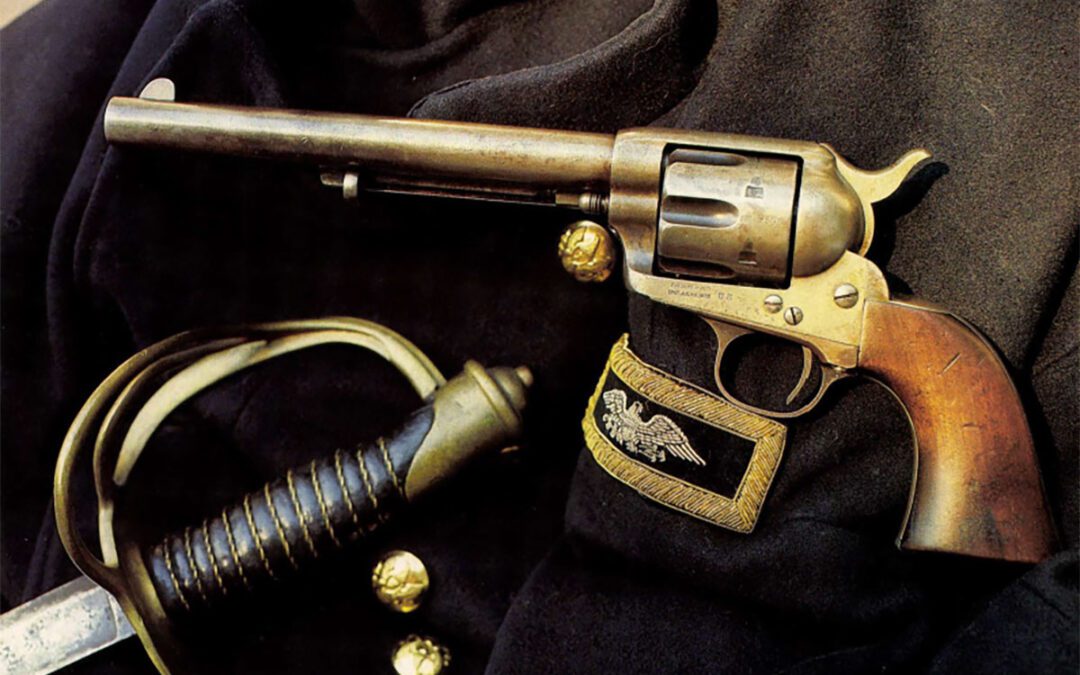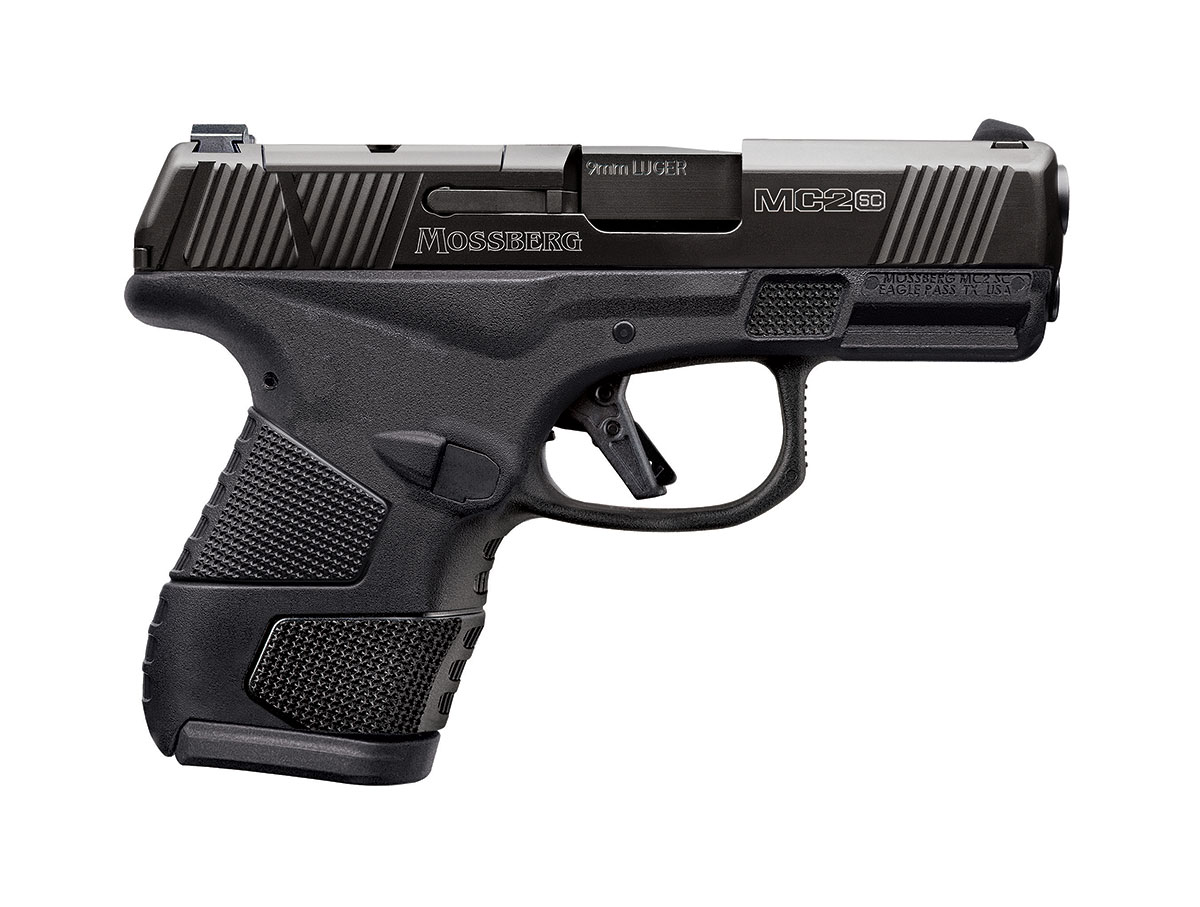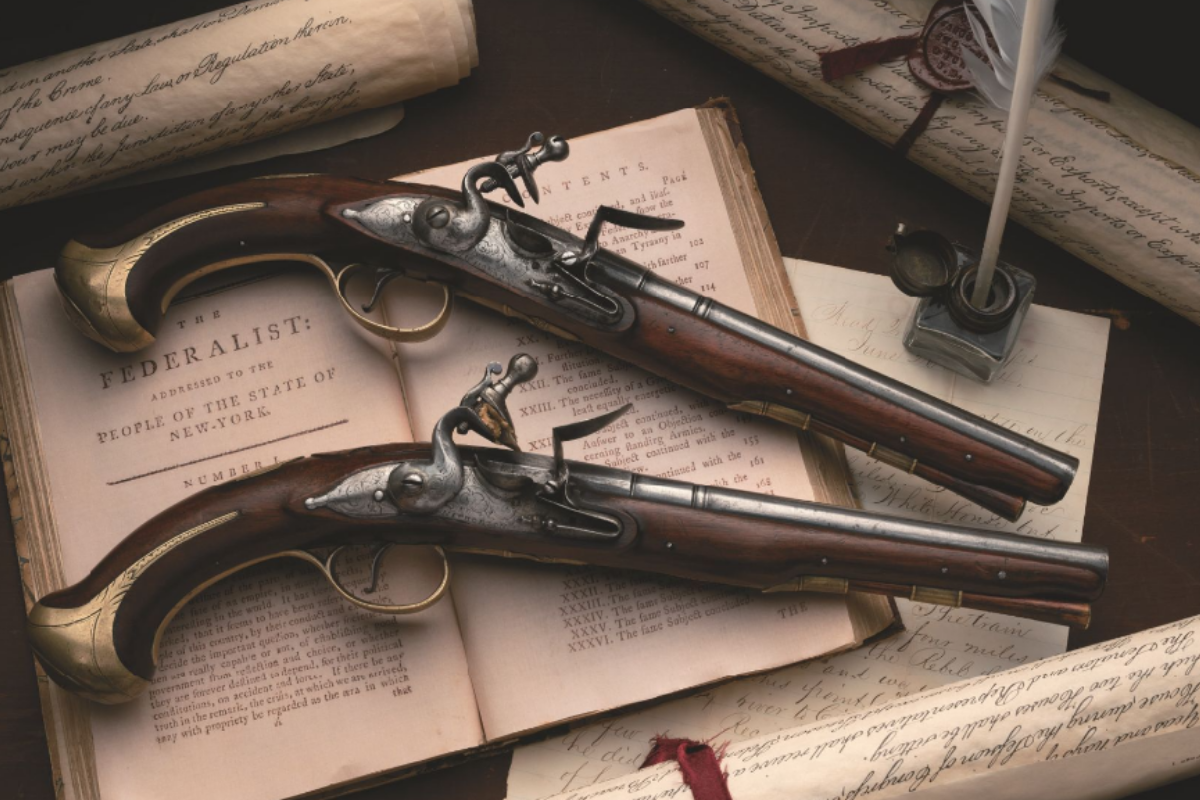For nearly two centuries, Samuel Colt’s firearms have been changing the course of history. And the legacy lives on.
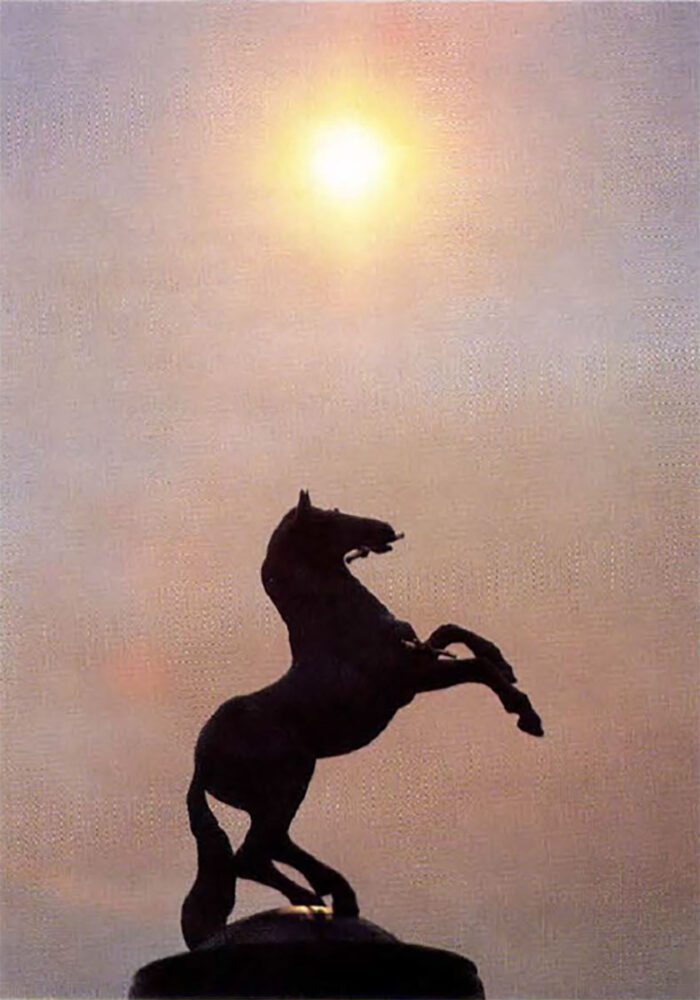
Statue of a Colt.
By all indications, he never should have succeeded in life, and if he had listened to what others told him, the name of Samuel Colt would probably be unknown today. After all, he had everything going against him. He was largely unschooled, and his letters and notes throughout his life reflected a profound inability to spell. His mother died when he was only seven and his father, having lost the family fortune in a West Indies trading venture, had to put the young boy and his three brothers in foster homes. Colt’s first three business endeavors turned into failures. His attempt to establish a pistol factory in London only lasted from 1852 to 1857 (although some rare variations of the 1851 and 1849 pistols were produced there). Of his five children, only one survived infancy. And as a final obstacle, Col. Samuel Caldwell Colt was left-handed, an oddity in a prejudiced Victorian world that insisted on doing things the “right” way.
Fortunately for firearms history, the Hartford, Connecticut native possessed two traits necessary for success: a remarkably strong sense of perseverance, and an uncanny dash of luck that would eventually put his unique “automatic repeating revolvers” in the right places at precisely the right times. Still, none of this came easily.
Born on July 14, 1814, Samuel Colt was introduced to handguns by his grandfather, a Revolutionary War veteran who presented the young boy with an old single-shot horse pistol. Colt became fascinated with weapons, which soon led him to examine a double rifle. He started wondering if a pistol could ever be made to fire more than twice without reloading. But opportunities for discovery and encouragement were nonexistent for a pre-teen lad in frontier America, especially when he was obviously ill-suited for formal education. Like so many geniuses both before and after his time, Colt’s temperament was not conducive to a structured schoolroom situation. Nonetheless, Colt became his own tutor and at age 11, he chanced upon a book entitled Compendium of Knowledge, which introduced him, among other things, to the wonders of gunpowder and the galvanic battery. Of even greater significance, it showed the boy that some people actually invented things, rather than simply accepting what was already in existence.
One year later, Sam Colt tried to resurrect his vision of a repeating firearm by lashing four rifle barrels together, so that each tube could be rotated to fire from the same lock. The experiment was a thunderous failure, but it chronicled the first multiple discharge of a Colt-made firearm. In another experiment, Colt announced that on July 4th, 1829, he would blow a raft “sky high” with an underwater fuse he had invented. This time the demonstration was a resounding success, but the mighty explosion drenched the elegantly dressed spectators, who proceeded to chase the young inventor through the Hartford township.
Four years later, at 16, Sam Colt was calling himself a self-styled inventor and adventurer (throughout his life he preferred to think of himself in these terms rather than as a gunmaker). He boarded the ship Corio, and worked his way to London and then Calcutta. The year was 1831 and it is notable because on this voyage Colt carved a crude, three-piece wooden device consisting of a hammer, a six-chambered cylinder and a dowel that would eventually become known as a cylinder base pin. The basic premise of Colt’s model was that the hammer rotated each chamber of the cylinder in line with the bore as the gun was being cocked. Colt may have gotten the idea from observing the spokes of the ship’s steering wheel lock up with its clutch, or he could have been inspired when he viewed some of the early multi-shot pistols which were on display in the Tower of London when his ship docked on the Thames.
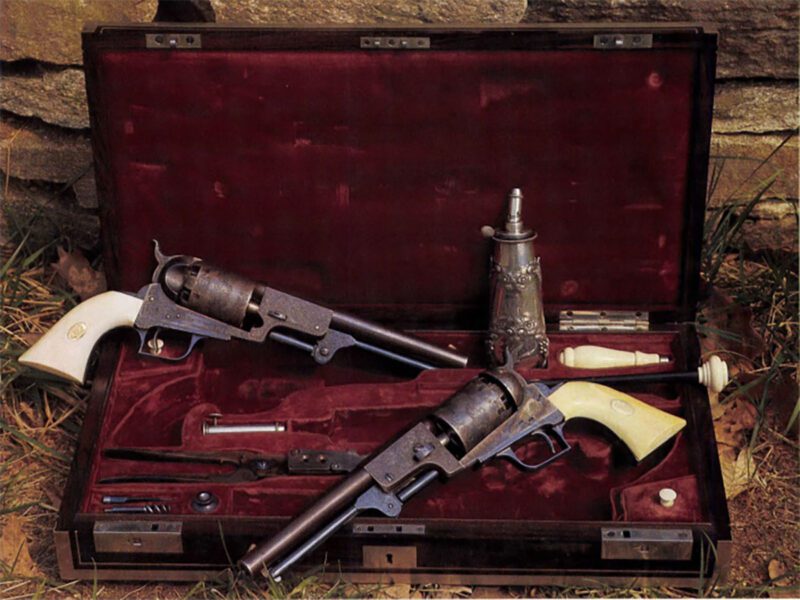
This 19th century set of Colt Second Model Dragoons is probably the fanciest pair in existence. Also called “horse pistols,” the large-framed handguns were popular with adventurers, explorers, and gunmen of the growing West.
Although revolving rifles and pistol had existed previously, their chambers had to be rotated into place by hand. Colt’s invention was the first in which the gun’s cylinders rotated automatically with each shot. This made fora faster shooting pistol that could be operated with one hand — at least that was Colt’s theory.
To prove his point, the young entrepreneur borrowed enough money from his father to have two prototype revolvers made. Unfortunately, Colt’s first public demonstration ended with one of the pistols failing to fire, while the other blew up in his hands. At this point, embarrassed and in debt, most men would have gone on toother pursuits. But Colt’s almost superhuman tenacity and dedication fired him with a determination that was to characterize his business dealings throughout his flamboyant life.
Having exhausted his credibility among potential investors, and needing money to further his revolving pistol experiments, he suddenly emerged as “the celebrated Dr. Coult.” He was soon touring the U. S. and Canada, charging 25 cents admission for people to see the effects of nitrous oxide (laughing gas), which he had discovered while working on his waterproof fuse. Not only did his unusual traveling act succeed in raising needed capital, but it enabled him to develop his talent as a showman, a kill that would play a major role in getting his guns accepted throughout the world.
In 1835, Colt went to Europe to try and interest investors in his new revolving gun invention. The venture failed, but Colt at least got his concept patented in England and France. Returning home, he obtained U. S. patent #138 on February 25, 1836. One month later, armed with his patent, some experimental models, and an arsenal of enthusiasm, Sam Colt convinced a cousin and several prominent New York businessmen to invest $230,000 to form the Patent Arms Manufacturing Company. Headquartered in a vacant silk mill on the banks of the Passaic River in Paterson, New Jersey, the company manufactured the now-famous and highly collectible Paterson Belt, Holster, and Pocket Pistols, along with revolving rifles, carbine , and shotguns. Many of the pistols had casehardened frames and some were ornately engraved for special presentation. All were hand finished, fitted, and assembled in varying degrees of perfection.
Unfortunately, the Paterson project failed due to a combination of elements. First, Colt pent lavish amounts of his investors’ money on elegant dinner parties in an effort to get prominent government and military authorities to accept his unique revolving pistol. Despite Colt’s marketing tactics, military men greeted his revolvers with prejudice. They found the guns awkward to hold, too small in caliber, and prone to malfunction when fired by anyone other than the inventor himself.
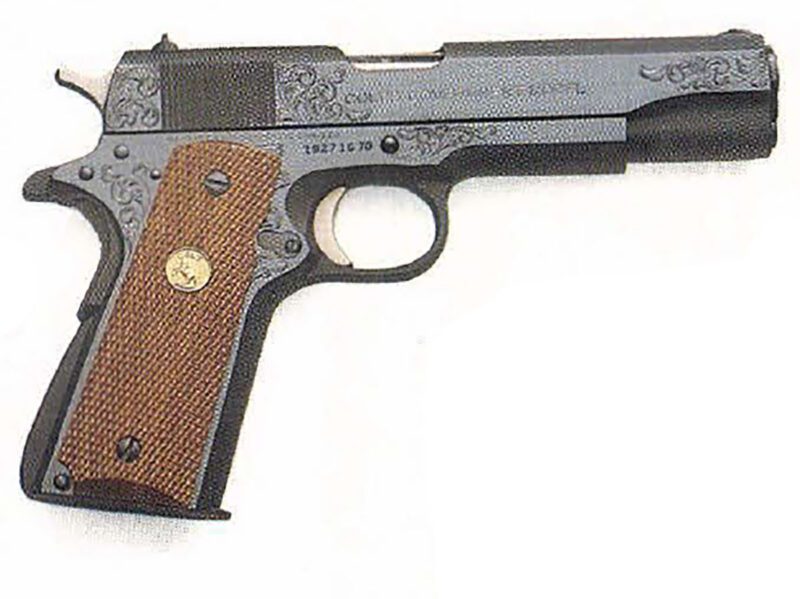
The Model 1911 Government, a .45 caliber semi-automatic, was the official Army sidearm in two wars. Over three million have been produced.
After repeatedly seeking lucrative military contracts, Colt was rewarded with an order for 100 guns by Col. William S. Harney, who believed the multi-shot rifles would put an end to the Seminole Indian War in the Florida Everglades. Later, the U.S. Army would order another 100 Paterson carbines on a trial basis. And in Texas, the new Republic’s Rangers ordered 460 Paterson products, including Holster Pistols, rifles and carbines.
Unfortunately, the orders were too little and too late to support the mounting debts of the Paterson venture. The financial backers pulled out and the plant, machinery, and remaining firearms parts were liquidated, leaving an embittered Sam Colt vowing to never again put his invention and his fate in the control of others. In all, an estimated2,850 Paterson pistols and 1,912 longarms were produced from 1836 until 1842, when the New Jersey operations ceased. Although deemed a financial failure, Paterson guns today are among the rarest of the Colt collectibles.
With renewed dedication, Colt began marketing a waterproof black powder/tinfoil cartridge, and through contacts made during his Paterson operation, managed to get Congress to appropriate $50,000 for the purchase of his ammunition. He also continued to experiment with underwater explosives and made headlines by blowing up a60-ton ship in the Potomac River while a crowd of spectators and government officials watched in amazement. During this time, Colt became friends with inventor Samuel F. B. Morse, and the two men formed a company to produce underwater telegraph cables. Unfortunately, the venture failed, and Colt was left penniless again.
Meanwhile, Colt’s Paterson Pistols were having far more success than their inventor. Frontiersmen fighting to open the West were blazing new legends that would form the foundation of the Colt mystique. One of the most notable incidents took place in 1844, when Captain John Hayes of the Texas Rangers and 15 of his men, all armed with Patersons, successfully fought off 80Comanches, killing or wounding half of the Indians. Around the wilderness campfires and frontier outposts, Colt’s Texas Patersons quickly became legendary. It was firmly believed among fighting men that more Colt revolvers would be needed if the West was to be won. When Captain Samuel Hamilton Walker entered Colt’s life, the destiny of the 33-year-old inventor took a quantum leap forward, never to break stride again. Walker and his men had used Colt’s revolvers in the wars in Mexico and Texas. The revolvers fired a charge of25 to 30 grains of black powder, which was not particularly devastating, but their ability to rapid fire was psychologically advantageous to mounted troops who needed firepower and maneuverability. What Walker wanted was an “improved” Colt capable of firing a notably heavier charge.
With Walker’s enthusiasm and his influence in Washington, a new gun was born: the celebrated Walker Colt, the largest and hardest-hitting black powder revolver ever produced. Weighing 4 pounds 9 ounces, the revolver featured a square-back brass trigger guard, a nine-inch barrel and a massive six-shot .44 caliber cylinder in which each chamber could easily hold 50 grains of powder. When fired, the Walker was so powerful that the loading lever usually broke away from its catch, which often prevented the cylinder from being rotated. The guns were usually issued in pairs and were designed for carrying in saddle holsters rather than on the belt.
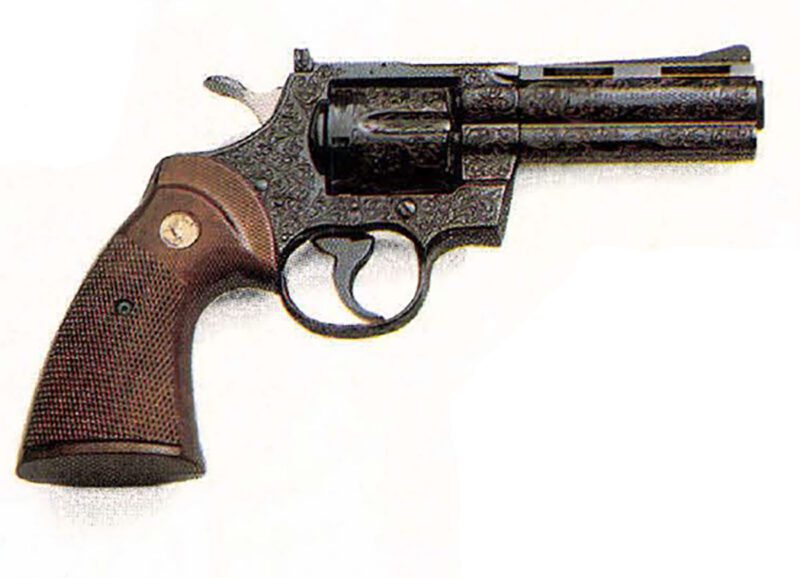
A highly-engraved Python with a four-inch barrel, produced by Colt’s Custom Shop.
Only 1,100 Walkers were produced, all in the shops of Eli Whitney because Colt had no facilities for manufacturing the guns. However, learning from his past experiences, he refused Whitney’s offer of a partnership. Although the Walker was an instant success with government troops, Coltlost money on the guns due to inaccurate cost accounting and his decision to contract labor and parts in order to shield some of his manufacturing procedures from Whitney. Colt sold his total production of Whitneyville Walkers to the government for $28,000, but they actually cost him $31 ,000 to produce! Today, a single pistol can easily bring $10,000 or more.
Buoyed by government orders and glowing endorsements from such famed personalities as Kit Carson and Sam Houston, Colt leased a building in 1848 and established the Colt Arms Manufacturing Company with $5,000 he borrowed from his cousin. It turned out to be his last loan. From then on, his fortune and fame began to soar with the expansion of the rest of the country. Although the U.S. Mounted Rifles (Dragoons) were the first “official” branch of the government to use Colt’s revolvers, subsequent improvements to the large-framed horse pistols found favor with adventurers, explorers, and gunmen of the growing West. The First, Second, and Third Model Dragoons featured (respectively) a reduced size and improved barrel latch (Model1848), rectangular bolt cuts instead of oval in the cylinder and a stronger leaf-style mainspring (Model 1849), and a rounded trigger guard and sturdier loading lever latch under the barrel (Model 1858).
The massive Dragoons were manufactured until 1861, but were eventually surpassed in popularity by the .36 caliber Model 1851 Navy, an easy-pointing six-gun favored by such marksmen as Wild Bill Hickok; and the sleek Model 1860Army, a .44 caliber revolver whose streamlined styling and improved non-binding ratchet loading lever made it appear almost futuristic.
Even more popular than the ’51 Navy and the ’60 Army was the diminutive Model 1849, a low-cost .31 caliber pocket pistol that Colt had unsuspectingly designed just intime for the California gold rush. The various models of pocket pistols, including the Baby Dragoon of 1848 and the hammerless so-called Wells Fargo Models, produced a steady stream of income for the now-burgeoning Colt armory. The easy-to-carry guns were snapped up by thousands of fortune hunters. Although the five- and six-shot pocket pistols sold for about $15 back in the “States” (as any place east of the Mississippi River was called), the reliable little Colts often went for as much as $100 apiece out West, adding to the desirability of owning a genuine “Colt’s revolver.”
In the 1850s, Colt anticipated the outbreak of the Civil War and increased his facilities, adding additional millions to his personal fortune. An avowed Democrat, he readily sold guns to both Yankees and Confederate forces until Union blockades put the bulk of his guns into Union hands.
By now, other cap-and-ball revolvers were appearing on the market, but Col. Colt (as Samuel was now called) had a proven flair for showmanship and an instinct for marketing strategy that kept his guns in the spotlight of public awareness. Colt parts were more readily obtainable, and the guns were more reliable (or so their users swore via published testimonials). Moreover, the exquisitely adorned presentation models were finding their way into the hands of the most influential folk heroes, military purchasing agents and politicians of the day.
Like many who had known early hardships, Sam Colt reveled in his ability to finally enjoy life, although he was a workaholic who put every ounce of his energy and enthusiasm into promoting and perfecting his guns. Only death could stop the tireless perseverance that had propelled him to the top.
Colt died in Hartford on January 14,1862, succumbing to the combined effects of overwork, gout, and rheumatic fever. But he left the world with a legacy that had changed the course of history on more than one occasion. His pallbearers included Thomas Seymour, former governor of Connecticut, and Henry Deming, Mayor of Hartford, and the city’s flags flew at half-mast as Samuel Colt was buried, with full military honors.
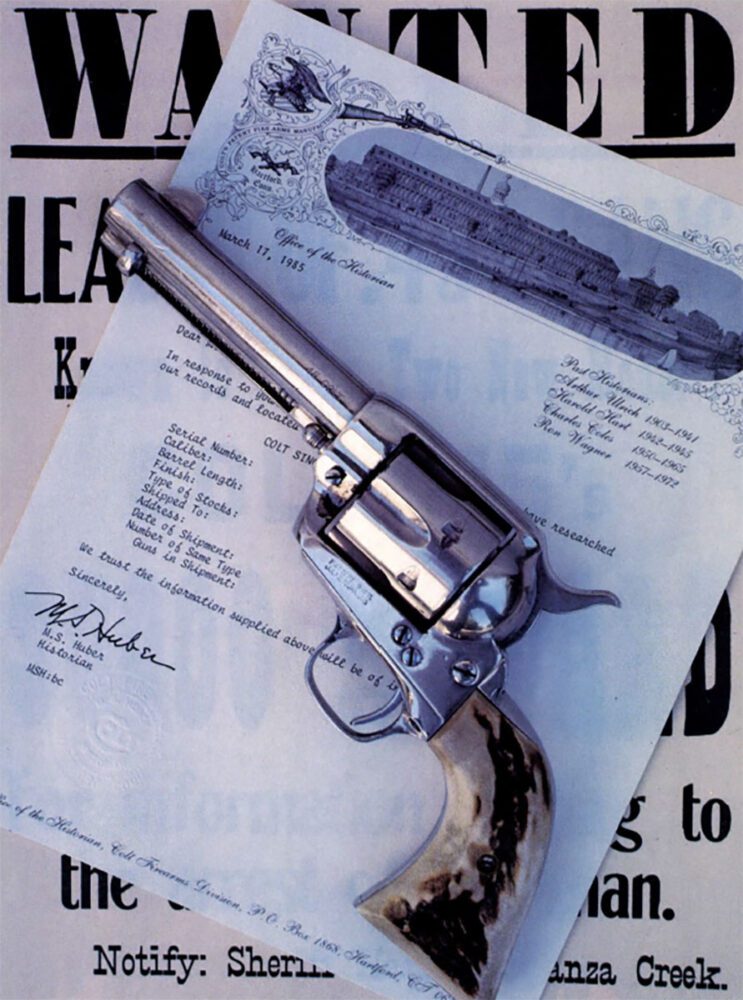
Respected historian Marty Huber researched all Colt firearm produced after 1864 (the year a factory fire destroyed the company’s records). Huber supplied the collector with an official Colt Firearms letter, which often provides interesting details that can enhance the value of the firearm.
If Colt sought immortality, he most assuredly found it in the industrial empire that he left. Even after his death, the Colt factory continued turning out hundreds of thousands of revolvers, muskets, and rifles for Union troops and westward-bound frontiersmen. A fire of mysterious origin (some say it was set by Confederate forces) destroyed the Colt factories in1864, but the empire was rebuilt by his widow Elizabeth within two years. By then, the War Between the States had ended, and a new era was beginning: the great Westward expansion. And in this most romantic scene from American history, the Single Action Army would play a dramatic role.
It was unfortunate that Samuel Colt never lived to see his company’s famous Model P – the .45 Army Model of1873. Of course, through its long and illustrious career, the six-shooter has had other names: Thumbuster, Hogleg, Peacemaker, Frontier Six-Shooter, Equalizer and Judge Colt, and His Jury of Six. It was the most famous handgun of the West and its popularity among collectors and shooters continues today, in spite of the fact that Colt discontinued cataloging the Single Action Army as of December 1981, a full 108 years after it was adopted as the official sidearm of the U. S. Army. The SAA was the first large-framed Colt revolver to feature a top strap and to be chambered for the new centerfire metallic cartridges (factory conversions notwithstanding). It quickly gained fame in the hands of lawmen and outlaws alike, including Wyatt Earp, Jesse James, Tom Hom, Bill Tilghman, and Bat Masterson. It was a rugged, fast-shooting gun that could function with half of its parts missing; all one really needed was the frame, hammer, cylinder, and barrel. First introduced with a 7 1/2-inch “Cavalry” barrel, the Colt SAA soon appeared with a 5 1/2-inch “Artillery” version and later with the popular 4 3/4-inch “Civilian” barrel.
In addition to the three standard barrel lengths, longer-barreled SAAs could be special ordered over the 7 1/2-inchversion, for a dollar an inch or with short 2- 3- and 4-inchvariations (referred to as “without ejector rod assembly” by the factory, the public and subsequently collectors have since dubbed them Sheriff’s Models, House Guns, and Storekeeper Models).
Throughout its legendary lifetime, the old Thumbuster demonstrated its remarkable versatility of design by being produced in 36 different calibers, ranging from the. 22 rimfire to the huge .476 Eley. However, in terms of total production, the most popular calibers were the .45 colt,.44-40, and the .38-40.
Besides being a rugged and reliable shooter, the ubiquitous Colt Single Action Army became popular among such noted engravers as L. D. Nimschke, Cuno Helfricht, and Gustave Young. By 1985, any Colt six-shooter with matching serial numbers in original finish commands a price ranging from $650 to $1 ,000. Prices soared to four-digits and sometimes beyond. The gun also has factory-produced special features such as custom barrel lengths or engraving.
Even after the frontier was tamed, the Peacemaker continued to win the West via the silver screen and in the hands of heroes like Bill Hart, Tom Mix and Harey Carey. Spilling over into television, the six-gun gained new followers in the holsters of “good guys” like Gene Autry, Roy Rogers, and John Wayne.
Today, the Colt six-shooter is clearly established as a part of Americana. Even though more than half a million Colt SAAs still exist, they continue to command the interest of shooter and collector alike. Such loyalty has not been lost on the Colt Firearms Company, for although the famous Peacemaker has been “discontinued,” special-order six-guns are still created at the factory’s Custom gun Shop. And single action commemoratives, which were introduced in 1861, have established a collecting niche of their own.
The development of other guns and firearms continued to play an important role in the continuing saga of the Colt Patent Firearms Company. They include Gatling guns, rifles, shotguns, double-action revolvers and automatics. One 20th-century sidearm deserves more than just a passing mention, and ironically, it too, is a “Colt. 45.”
The Model 1911 is the most widely collected of the automatic Colts, and with good reason. Having saved as the official sidearm in two World Wars, the Korean conflict, and Viet Nam, it is the most familiar of all the military arms to a vast majority of Americans (well over three million Colt 1911 Government .45s have been produced.) Chided by many servicemen as being inaccurate, the Model 1911 automatic has nonetheless won more centerfire pistol championships than any other handgun in history. Samuel Colt’s legacy continues to make history.
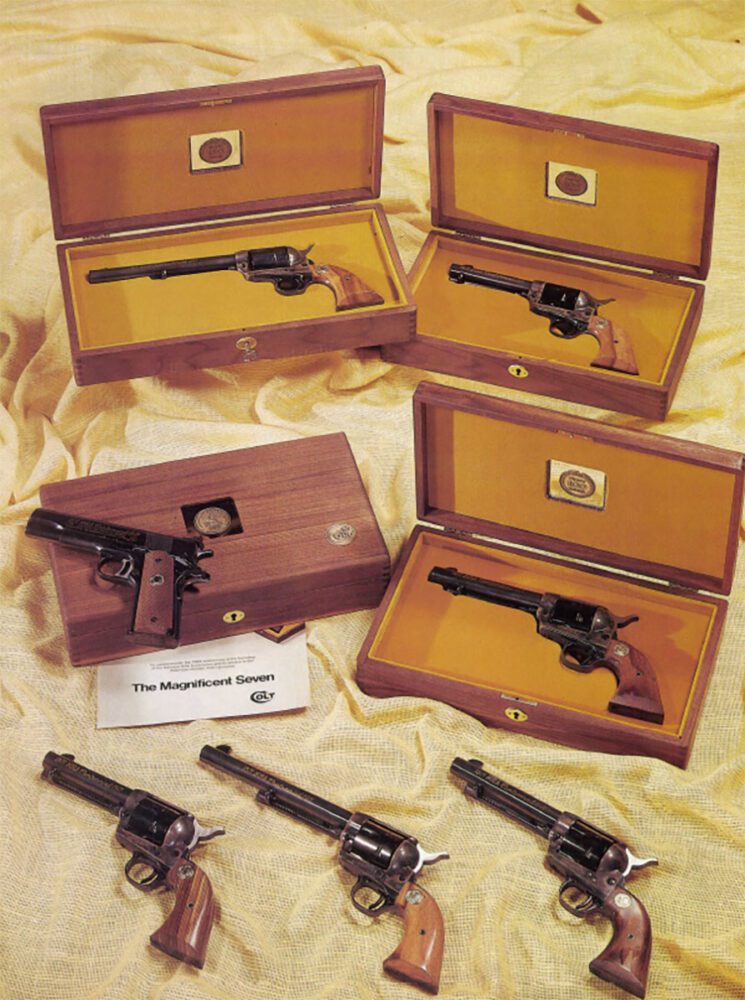
This set of seven guns, all with matching serial numbers, was produced by the Colt Custom Gun Shop in 1971 for the 100th Anniversary of the National Rifle Association. The set is typical of the many multiple-gun collectibles created by the Custom Shop since it was re-established in 1976.
In 1955, the Python ushered in a new standard in double-action handguns. In 1961, the creation of 7,390, 125th Anniversary Single Action Armies established a viable and lasting commemorative market for collectors. And in 1982, when Colt introduced its first stainless steel handgun, the Model 1860 Army was chosen for this honor; stainless steel versions of the 1851 and 1861 Navies and the 1862 Pocket Navy and Pocket Police were also produced in 1982-83, but the limited run of only 1,500 guns in each model has made these sought after by more collectors than shooters.
In 1986, to help celebrate its 150th Anniversary, Colt Industries (as the Fortune 500 company is now known) created four versions of special commemorative guns. First and rarest was a one-of-a-kind “Theme Gun,” a Single Action Army with gold-inlayed engraving that depicts the famous rampant colt, armory dome and other “Cantina” features. That gun was auctioned off for charity. The next was a 1,000 edition of the 150th Anniversary SAA, featuring full presentation engraving and ivory grips. Third was the Double Diamond Jubilee set of two matched revolvers: a Colt Officer‘s ACP. This unique combination was displayed in a special contemporary-styled glass case. Finally, a choice of any of the four handguns in circulation at the time were offered as a set. Each gun was nickel plated and featured B (one-half coverage) engraving styled after the early designs of Young and Nimschke. And from 1986 on, the rampant Colt medallions in each grip were updated and all guns came with a new maroon and gold commemorative box. But perhaps the spirit of Colt could best be summed up by a quote from the company’s 1936 catalog:
“His was the mind of a genius, planner and a dreamer, all in one. His vision was not local, but world-wide. His ambition exceeded mere prosperity and power…complete satisfaction could only be his when he had reached the pinnacle in his chosen field. His own deeds and the life he lived have immortalized him…and the products that still bear his name represent a constant tribute to his ability and his resourcefulness.”
These words are just as fitting today as they were in 1936 — for even today history is still being made.
Editor’s Note: This article originally appeared in the 1985 Nov./Dec. issue of Sporting Classics.
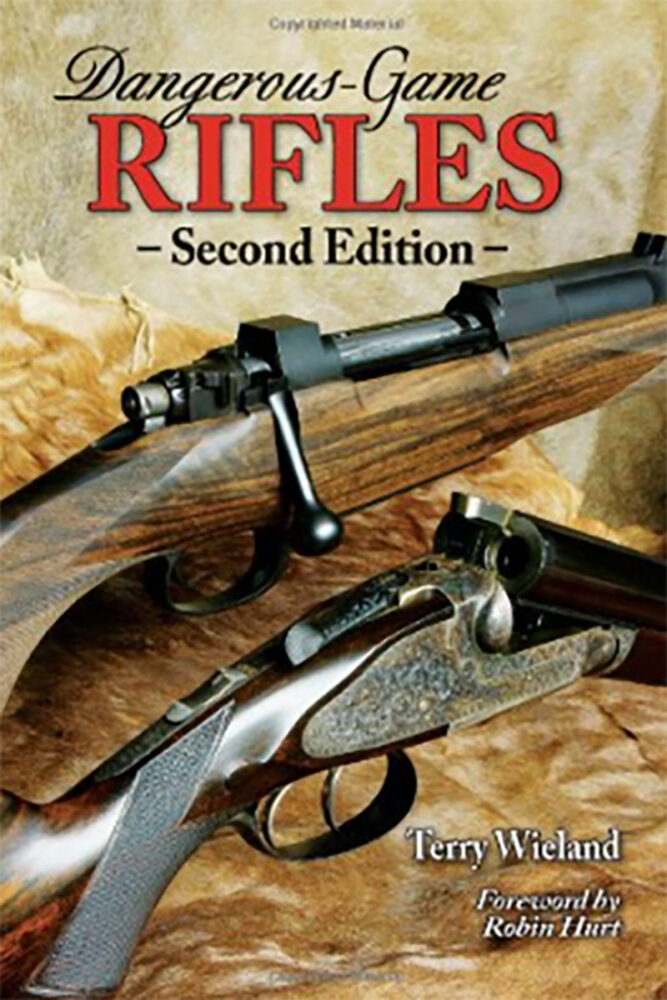 In this book, firearms expert Terry Wieland explores the history of big-bore rifles for dangerous game, covers rifles and ammunition available today, examines controversies about killing power, and explains the nuances of big rifles and how to use them. Buy Now
In this book, firearms expert Terry Wieland explores the history of big-bore rifles for dangerous game, covers rifles and ammunition available today, examines controversies about killing power, and explains the nuances of big rifles and how to use them. Buy Now

